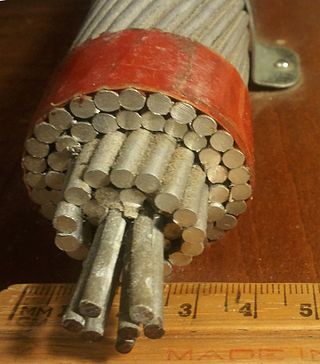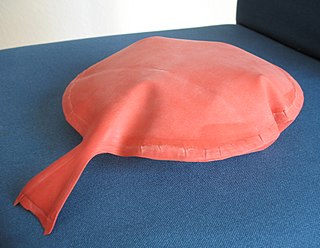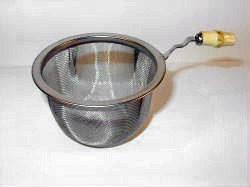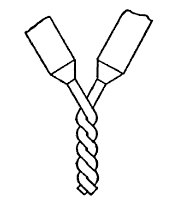Related Research Articles

A wire is a flexible, round, bar of metal. Wires are commonly formed by drawing the metal through a hole in a die or draw plate. Wire gauges come in various standard sizes, as expressed in terms of a gauge number or cross-sectional area.

In textile production, carding is a mechanical process that disentangles, cleans and intermixes fibres to produce a continuous web or sliver suitable for subsequent processing. This is achieved by passing the fibres between differentially moving surfaces covered with "card clothing", a firm flexible material embedded with metal pins. It breaks up locks and unorganised clumps of fibre and then aligns the individual fibres to be parallel with each other. In preparing wool fibre for spinning, carding is the step that comes after teasing.

Peanut butter is a food paste or spread made from ground, dry-roasted peanuts. It commonly contains additional ingredients that modify the taste or texture, such as salt, sweeteners, or emulsifiers. Consumed in many countries, it is the most commonly used of the nut butters, a group that also includes cashew butter and almond butter.

Glossary of climbing terms relates to rock climbing, mountaineering, and to ice climbing.

A whoopee cushion is a practical joke device, which emulates the sound of flatulence.

In rock climbing, a nut is a metal wedge threaded on a wire that climbers use for protection by wedging it into a crack in the rock. Quickdraws are clipped to the nut wire by the ascending climber and the rope threads through the quickdraw. Nuts come in a variety of sizes and styles, and several different brands are made by competing manufacturers. Most nuts are made of aluminum. Larger nuts may be threaded on Dyneema cord instead of wire, but this has become unusual.

A joy buzzer is a practical joke device that consists of a coiled mainspring inside a disc worn in the palm of the hand. When the wearer shakes hands with another person, a button on the disc releases the spring, which rapidly unwinds creating a vibration that mimics an electric shock to the unsuspecting victim.

A mesh is a barrier made of interlaced strands of metal, fiber or other flexible or ductile materials. A mesh is similar to a web or a net in that it has many interwoven strands.

A pin is a device, typically pointed, used for fastening objects or fabrics together. Pins can have the following sorts of body:

A Mason jar, also known as a canning jar, preserves jar or fruit jar, is a glass jar used in home canning to preserve food. It was named after American tinsmith John Landis Mason, who patented it in 1858. The jar's mouth has a screw thread on its outer perimeter to accept a metal ring or "band". The band, when screwed down, presses a separate stamped steel disc-shaped lid against the jar's rim.

A practical joke or prank is a trick played on people, generally causing the victim to experience embarrassment, perplexity, confusion, or discomfort. The perpetrator of a practical joke is called a "practical joker" or "prankster". Other terms for practical jokes include gag, rib, jape, or shenanigan. Some countries in western nations make it tradition to carry out pranks on April Fools' Day and Mischief Night.

A fish tape is a tool used by electricians to route new wiring through walls and electrical conduit.

A practical joke device is a toy intended to confuse, frighten, or amuse individuals as a prank. Often, these toys are harmless facsimiles of otherwise potentially disgusting or terrifying objects, such as vomit or spilled nail polish. In other instances, they are created as seemingly harmless items designed to humorously malfunction in such a way as to confuse or harm the target of a prank. The devices are frequently sold in magic or specialty shops, purchased over the Internet, or crafted for oneself. The most notable joke deviceis the whoopee cushion.
Koh-Kae is a Thai brand of nut snacks manufacturing by Mae-Ruay Snack Food Factory Co., Ltd. and was first sold in 1976. In its early days, Koh-Kae only came in their original flavor, which is coconut cream coated peanuts, but they developed others flavor such as tom-yum and chicken flavor later on. By 2000, Mae-Ruay Snack Food Factory Co., Ltd. was awarded ISO 9001 certification by BVQI Institute, followed by the GMP and HACCP system certification by BVQI in 2002. In year 2019 Koh-Kae holds 50% of Thailand nut snacks market share.

A writing material, also called a writing medium, is a surface that can be written on with suitable instruments, or used for symbolic or representational drawings. Building materials on which writings or drawings are produced are not included. The gross characterization of writing materials is by the material constituting the writing surface and the number, size, usage, and storage configuration of multiple surfaces into a single object. Writing materials are often paired with specific types of writing instruments. Other important attributes of writing material are its reusability, permanence, and resistance to fraudulent misuse.

The GINA Light Visionary Model is a fabric-skinned shape-shifting sports car concept built by BMW. GINA stands for "Geometry and functions In 'N' Adaptions". It was designed by a team led by BMW's head of design, Chris Bangle, who says GINA allowed his team to "challenge existing principles and conventional processes." Other designers include Anders Warming.

A rat-tail splice, also known as a twist splice or a pig-tail splice, is a basic electrical splice that can be done with both solid and stranded wire. It is made by taking two or more bare wires and wrapping them together symmetrically around the common axis of both wires.
In American folklore, the snow snake is a fearsome critter that, unlike other reptiles, can live in cold temperatures and is only active during winter months.
An Indian burn, also known as a snake bite or Chinese burn in the UK and Australia, is a pain-inducing prank, where the prankster grabs onto the victim's forearm or wrist, and starts turning the skin away from themselves with one hand, and with another hand towards themselves, causing an unpleasant burning sensation to the skin. The prank is popular in a school setting.
References
- ↑ Zolotow, Maurice (1952). It Takes All Kinds. Random House. p. 116. Archived from the original on Dec 23, 2011.